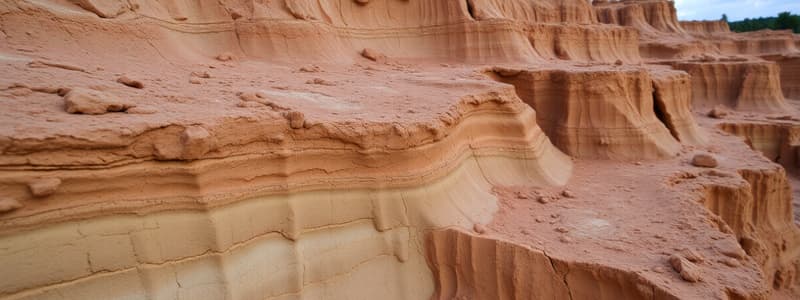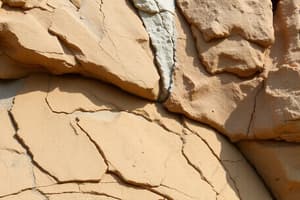Podcast
Questions and Answers
Which of the following processes is primarily responsible for the rounding of sediments during the formation of detrital sedimentary rocks?
Which of the following processes is primarily responsible for the rounding of sediments during the formation of detrital sedimentary rocks?
- Dissolution of unstable minerals
- Precipitation of cementing agents
- Chemical reactions with organic matter
- Abrasion during transport by mobile agents (correct)
Which of these scenarios is the MOST likely to result in the formation of a chemical sedimentary rock?
Which of these scenarios is the MOST likely to result in the formation of a chemical sedimentary rock?
- Lithification of volcanic ash deposits after a major eruption.
- Accumulation and compaction of plant material in a swamp.
- Precipitation of calcium carbonate from a supersaturated solution in a cave. (correct)
- Deposition of weathered rock fragments in a high-energy river environment.
How does differential stress differ from confining pressure in the context of metamorphism?
How does differential stress differ from confining pressure in the context of metamorphism?
- Differential stress occurs at shallow depths, while confining pressure occurs at great depths.
- Confining pressure is directed, while differential stress is equal in all directions.
- Confining pressure causes foliation, while differential stress causes recrystallization.
- Differential stress is directed, while confining pressure is equal in all directions. (correct)
What is the primary difference between 'rock cleavage' and 'schistosity' as foliated metamorphic textures?
What is the primary difference between 'rock cleavage' and 'schistosity' as foliated metamorphic textures?
Which of the following best describes the role of 'biological activity' in mechanical weathering?
Which of the following best describes the role of 'biological activity' in mechanical weathering?
If a soil profile consists of thick organic layer with a thin topsoil and is acidic, which climate is MOST likely responsible for its formation?
If a soil profile consists of thick organic layer with a thin topsoil and is acidic, which climate is MOST likely responsible for its formation?
Which of the following describes how 'hydrolysis' contributes to chemical weathering?
Which of the following describes how 'hydrolysis' contributes to chemical weathering?
A geologist discovers a metamorphic rock composed primarily of amphibole minerals with a strongly aligned, banded appearance. Which metamorphic texture is MOST likely observed?
A geologist discovers a metamorphic rock composed primarily of amphibole minerals with a strongly aligned, banded appearance. Which metamorphic texture is MOST likely observed?
During diagenesis, what is the key difference between 'compaction' and 'cementation' in the lithification process?
During diagenesis, what is the key difference between 'compaction' and 'cementation' in the lithification process?
Which of the following successions accurately describes the expected transformation of shale under increasing grades of metamorphism?
Which of the following successions accurately describes the expected transformation of shale under increasing grades of metamorphism?
Flashcards
Weathering
Weathering
The chemical and physical processes that break down rock at Earth's surface.
Mass Wasting
Mass Wasting
The downslope movement of rock, regolith, and soil under the direct influence of gravity.
Erosion
Erosion
Processes that break down and carry away rock, sand, and soil by mobile agents
Mobile agents
Mobile agents
Signup and view all the flashcards
Types of mechanical weathering
Types of mechanical weathering
Signup and view all the flashcards
Types of chemical weathering
Types of chemical weathering
Signup and view all the flashcards
Controls of soil formation
Controls of soil formation
Signup and view all the flashcards
Soil Profile (horizons)
Soil Profile (horizons)
Signup and view all the flashcards
Detrital Sedimentary Rocks
Detrital Sedimentary Rocks
Signup and view all the flashcards
Chemical Sedimentary Rock
Chemical Sedimentary Rock
Signup and view all the flashcards
Study Notes
- Earth's external processes include weathering, mass wasting, and erosion, which shape the Earth's surface.
Weathering
- Weathering involves chemical and physical processes that disintegrate rocks on Earth's surface.
Mass Wasting
- Mass wasting is the movement of rock, soil, and regolith downhill due to gravity.
Erosion
- Erosion is where mobile agents remove broken-down materials.
- Mobile agents include water, wind, ice, and gravity.
Types of Mechanical Weathering
- Frost wedging: water freezes and expands in cracks.
- Salt crystal growth: salt crystals grow and exert pressure.
- Sheeting/unloading: reduces pressure, causing expansion and fracturing.
- Biological activity: plants and animals break down rocks.
Types of Chemical Weathering
- Dissolution: minerals dissolve in water.
- Oxidation: minerals react with oxygen.
- Hydrolysis: minerals react with water, changing its chemical structure.
Controls of Soil Formation
- Parent material: the original rock that breaks down to form soil.
- Time: how long the soil has been developing.
- Climate: temperature and precipitation patterns.
- Plants and animals: organic matter and biological activity.
- Topography: the shape and slope of the land.
Soil Profile
- O horizon: organic matter.
- A horizon: topsoil, rich in organic matter.
- E horizon: zone of leaching (eluviation), where minerals are dissolved and carried away.
- B horizon: subsoil, accumulation of leached minerals.
- C horizon: partially altered parent material.
- True soil consists of O, A, E, and B horizons.
Types of Sedimentary Rocks
- Detrital sedimentary rocks: formed from fragments of other rocks.
- Chemical sedimentary rocks: minerals precipitate out of solution.
Detrital Sedimentary Rocks
- Composed of physical fragments such as sand, silt, clay, or gravel.
- Examples include shale, sandstone, conglomerate, and breccia.
Chemical Sedimentary Rocks
-
Formed when minerals precipitate from a solution, often water.
-
Examples include limestone, chert, and rock salt.
-
Shale is the most common sedimentary rock.
-
Limestone is the most common chemical sedimentary rock.
-
Travertine is the most common inorganic limestone.
Diagenesis
- Encompasses the chemical, physical, and biological changes that occur after sediment deposition and burial.
Lithification
- Lithification transforms loose sediments into solid rock.
- Compaction occurs as sediments are pressed together under their own weight.
- Cementation is the process of minerals crystallizing among sediment grains.
Agents of Metamorphism
- Heat
- Confining pressure
- Differential stress
- Chemically active fluids
- Heat is the most important agent.
Metamorphic Textures
- Foliated: minerals are aligned in a parallel manner.
- Non-foliated: minerals are not aligned.
Foliated Metamorphic Textures
- Rock or slaty cleavage: rocks split into thin sheets.
- Schistosity: platy minerals are visible and aligned.
- Gneissic: minerals are segregated into bands.
Non-Foliated Metamorphic Textures
- Porphyroblastic: large crystals in a fine-grained matrix.
- Marble.
- Quartzite.
Common Foliated Metamorphic Rocks
- Shale transforms into slate.
- Slate becomes phyllite.
- Phyllite becomes schist.
- Schist becomes gneiss.
Common Non-Foliated Rocks
- Marble forms from limestone.
- Quartzite forms from sandstone.
- Hornfels forms from shale.
Studying That Suits You
Use AI to generate personalized quizzes and flashcards to suit your learning preferences.




